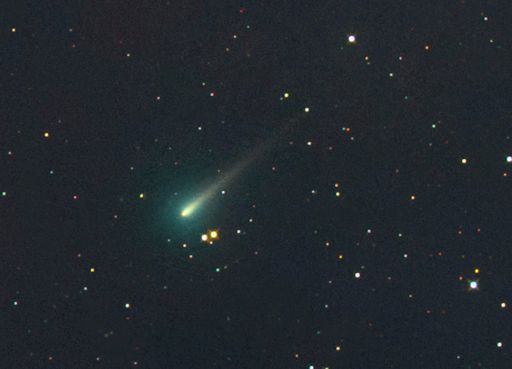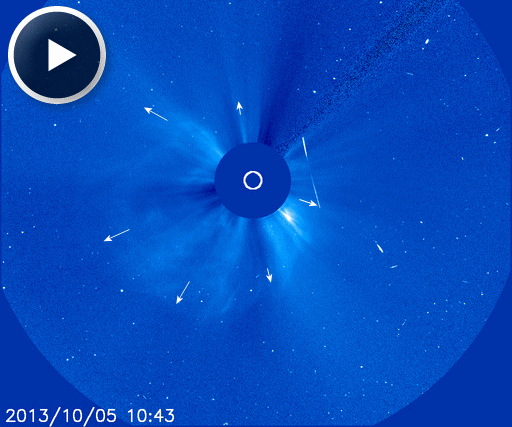They came from outer space--and you can have one! Genuine meteorites are now on sale in the Space Weather Store. | | |
SPACECRAFT GOES INTO LUNAR ORBIT: Mission controllers flying NASA's Lunar Atmosphere and Dust Environment Explorer (LADEE) spacecraft are among the select few at the space agency who have exemptions allowing them to work during the government shutdown. Early this morning, Oct. 6th, they fired LADEE's main engine in a braking maneuver. This slowed the spacecraft enough for it to be captured by the Moon's gravity. The insertion burn went flawlessly and LADEE is now in lunar orbit. Two more main engine burns, on Oct. 9th and 12th, will adjust LADEE's trajectory, settling it into its commissioning orbit. LADEE is on a mission to study the exotic and diaphanous lunar atmosphere, which is mightily affected by space weather.
COMET ISON IN COLOR: Comet ISON is brightening as it approaches the sun. Estimates by experienced observers put the comet between 10th and 11th magnitude. That's too dim to see with the unaided eye, but bright enough for color photography through mid-sized backyard telescopes. Michael Jäger of Weißenkirchen, Austria, observed the comet on Oct. 5th and found that it was green:

To image the comet, Jäger combined multiple exposures through red, green, blue, ultraviolet and infrared filters. Details may be found here.
ISON's green color comes from the gases surrounding its icy nucleus. Jets spewing from the comet's core probably contain cyanogen (CN: a poisonous gas found in many comets) and diatomic carbon (C2). Both substances glow green when illuminated by sunlight in the near-vacuum of space.
Finding Comet ISON is easy. It rises alongside Mars in the eastern sky just before dawn. Amateur astronomers, if you have a GOTO telescope, enter these coordinates. Sky maps: Oct. 7, 8.
The comet merits watching in the weeks ahead. While many experts believe ISON is on track to become a bright sungrazer in late November, astronomer Ignacio Ferrin of the University of the Antioquia Institute of Physics in Colombia predicts a different outcome. He believes Comet ISON is about to disintegrate. The light curve of ISON, Ferrin argues, resembles those of other comets that have fallen apart prematurely. If he's right, the "Comet of the Century" could turn into a century-class fizzle. Stay tuned to the Comet ISON Photo Gallery for updates.
Realtime Comet ISON Photo Gallery
FARSIDE CORONAL MASS EJECTION: The Earthside of the sun is quiet, but the farside of the sun is not. During the early hours of Oct. 5th, NASA's STEREO-A probe, stationed over the farside, recorded the eruption of a southern hemisphere sunspot. Shortly after 07:30 UT, a coronal mass ejection (CME) flew over the sun's southeastern limb (credit: SOHO):

Radio emissions from shock waves in the CME suggest an expansion velocity of about 700 km/s (1.6 million mph), which is fairly typical of CME speeds. If Earth were in the line of fire, we would probably observe bright polar auroras in a few days. However, this CME is heading away from, not toward our planet.
The active region that produced the blast will rotate onto the Earthside of the sun in about 6 days. If it remains potent, geoeffective solar activity could increase next week. Solar flare alerts: text, voice.
Realtime Space Weather Photo Gallery
Realtime Aurora Photo Gallery

